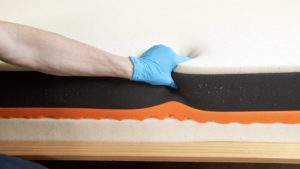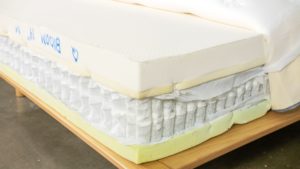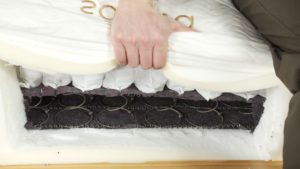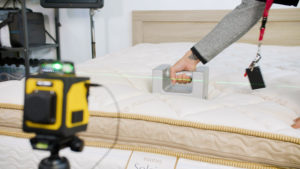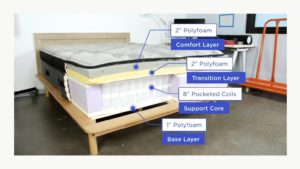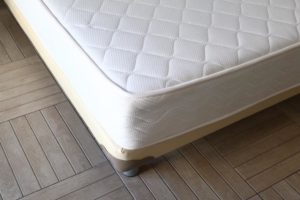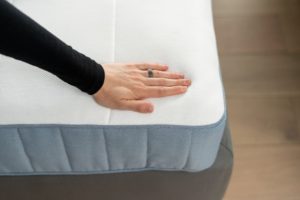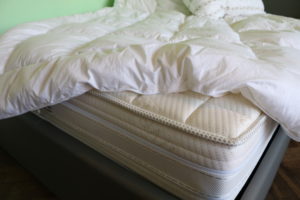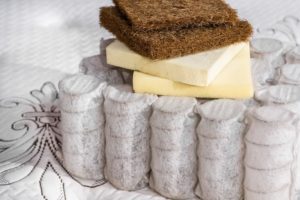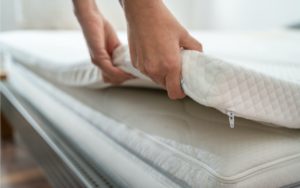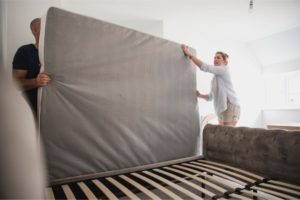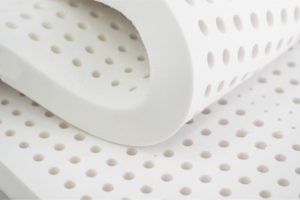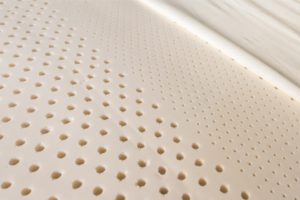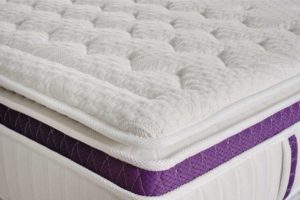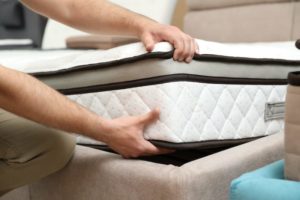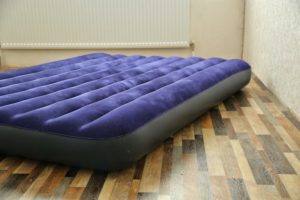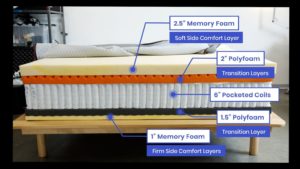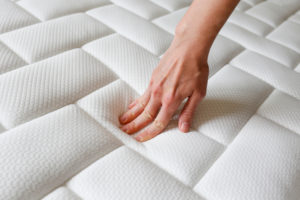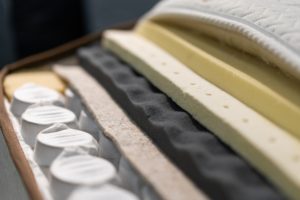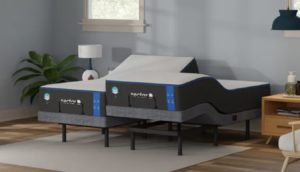When you buy through our links, we may earn a commission. Products or services may be offered by an affiliated entity. Learn more.
Memory Foam vs. Hybrid Mattresses
Choosing a mattress type is one of the first steps in shopping for a new bed. Memory foam and hybrids are two of the most common kinds of mattresses on the market, with each offering distinct potential benefits. While they share some similarities in construction and performance, shoppers should consider the key differences before making a purchase.
To help you determine which type is right for you, we’ll dig into what makes memory foam and hybrid mattresses unique. We’ll compare the features and performance of both and discuss availability, pricing, and other information to help you decide if one of these popular designs fits your needs.
Let us help you find the perfect bed
Answer a few questions to find the right mattress for your unique needs
Memory Foam Mattress Overview
Memory foam, also known as viscoelastic foam, was originally designed by NASA to use as cushioning in aircraft seats. Thanks to its close-conforming pressure relief, memory foam has become a popular material in the mattress industry.
While each model is different, most memory foam mattresses consist of a memory foam comfort system over a high-density polyfoam support core. Some memory foam mattresses also incorporate other materials, such as latex and specialty polyfoam, into their construction to increase durability, responsiveness, and/or temperature neutrality.
Memory foam mattresses cradle the body, which can help distribute weight away from pressure points. However, these conforming properties can also trap heat, which may be uncomfortable for some sleepers. That is why many manufacturers infuse the foam with substances like gel or copper, which are intended to draw heat away from the body. Covers designed for cooling and other materials engineered to wick away heat may also enhance the temperature neutrality.
Memory foam beds are popular and widely available. While prices vary, the average cost of a queen size all-foam mattress is between $800 and $2,500.
Advantages of Memory Foam Mattresses
Memory foam is a highly contouring material that offers many potential benefits.
- Enhanced Pressure Relief: Memory foam typically conforms closely to the body, redistributing weight away from sharp pressure points, such as the hips and shoulders.
- Excellent Motion Isolation: Memory foam absorbs motion well, which can be useful for couples who are sensitive to vibrations traveling across the surface of the bed.
- Hugging Sensation: Because of its close-conforming properties, many sleepers compare sleeping on memory foam to the sensation of being hugged.
Disadvantages of Memory Foam Mattresses
Despite the popularity of memory foam mattresses, potential drawbacks exist.
- Tendency to Overheat: When memory foam shapes to the body, it can trap heat. Many manufacturers attempt to improve the temperature neutrality by using special materials or construction techniques designed for cooling.
- Motion Inhibition: Because memory foam contours to the body and sinks under pressure, it can create a “quicksand” feeling that inhibits movement and feels uncomfortable to some sleepers.
- Susceptible to Off-Gassing: Memory foam is particularly susceptible to off-gassing odors due to volatile organic compounds (VOCs) that linger from manufacturing.
Hybrid Mattress Overview
Hybrid mattresses combine design elements from other mattress types, pairing the coil-based support core of innersprings with a thick comfort system similar to those found in latex or foam models. This combination often provides a balance of pressure relief and responsiveness.
Most hybrid mattresses use a pocketed coil support core, which contributes to a durable, springy, and breathable surface with minimal motion transfer and stable edge support. Hybrids may also use other coil types, including Bonnell, offset, or continuous wire, which are often affordable but more prone to motion transfer.
The materials and composition of hybrid comfort systems differ between models. They may include memory foam, polyfoam, latex, microcoils, fiber, or some combination of these components. Most hybrid comfort systems are designed to cradle the body, relieve pressure, and limit motion transfer.
Hybrid beds are very popular and can be found both online and in-store through most mattress retailers. Shoppers should note that each model varies in feel and performance, so it is important to analyze the specific design to select a hybrid that fits your needs. Hybrid models typically cost between $1,200 and $2,000 for a queen size.
Advantages of Hybrid Mattresses
Though a wide range of hybrid mattresses is available, most share common benefits.
- Increased Temperature Regulation: Thanks to the coil support system, hybrid mattresses tend to sleep cooler than all-foam models. Air travels through the core, which can help prevent overheating.
- Enhanced Ease of Movement: Coil support makes a sleep surface bouncier and more responsive, enabling sleepers to change positions more easily. This trait may also be beneficial for sex.
- Ample Edge Support: Because of their coil support cores, most hybrid models have sturdy edges. This can allow sleepers to use the entire surface without feeling like they’re sagging.
Disadvantages of Hybrid Mattresses
Hybrid mattresses are ideal for many sleepers, but some may have drawbacks.
- Tend To Be Heavier: Hybrid mattresses are usually heavier than other options because of their steel coil systems. This can make them more difficult to maneuver and set up.
- Higher Cost: Hybrid models have a higher average cost than all-foam models, though budget-friendly options are also available.
- Potential for Noise and Motion Transfer: Coil cores are more likely to produce noise and/or transfer motion than polyfoam support systems.
Memory Foam vs Hybrid Mattresses
Both memory foam and hybrid mattresses often use thick comfort systems to relieve pressure and limit motion transfer. As the name implies, memory foam mattresses use memory foam, but some models also incorporate other materials to adjust the feel and performance.
The contents of a hybrid’s comfort system may vary more, potentially including latex, polyfoam, memory foam, microcoils, fiber, or a combination of several materials.
Beneath their comfort systems, many models have transitional layers. Both memory foam and hybrid mattresses frequently use polyfoam to limit excessive sinkage and relieve pressure. However, memory foam and latex transition layers are also common, and some hybrid models use microcoils.
The main difference between memory foam mattresses and hybrid models lies in the support core. While memory foam mattresses typically contain a high-density polyfoam core, hybrids use a coil system. Polyfoam cores usually perform better in motion isolation and noise control, but coil systems tend to earn higher marks for bounce, breathability, and edge support.
| Memory Foam | Hybrid | |
|---|---|---|
| Typical Price Range | $800 to $2,500 | $1,200 to $2,000 |
| Overall Feel | Close-conforming with above-average motion isolation and pressure relief | Balanced conforming and responsiveness |
| Advantages |
|
|
| Disadvantages |
|
|
Who Should Choose a Memory Foam Mattress?
Memory foam mattresses traditionally offer excellent pressure relief.
You should choose a memory foam mattress if:
- You prefer deep contouring. Memory foam cradles the body with a hugging sensation that many sleepers find comfortable. This can help reduce or prevent discomfort in common pressure points, which may be ideal for sleepers with aches and pains.
- You sleep on your side. Side sleepers place considerable pressure on wider areas of the body, like the hips and shoulders. Because memory foam conforms closely, it can help distribute weight away from these pressure points.
- You awaken easily. A memory foam mattress can virtually eliminate motion transfer and mattress noise, which may appeal to sleepers who tend to wake up whenever their partner moves.
Who Should Choose a Hybrid Mattress?
Hybrid mattresses pair the responsive support of coils with the contouring properties of substantial comfort systems.
You should choose a hybrid mattress if:
- You prefer more bounce. Their coil support cores tend to make hybrid models bouncier and easier to move on. Sleepers who value the responsiveness of an innerspring bed but want greater pressure relief may enjoy the feel of a hybrid mattress.
- You tend to sleep hot. Air circulation through the coil system allows significant heat dissipation, which can help hybrid models maintain a more neutral temperature that’s appropriate for many hot sleepers.
- You use the edge of the bed extensively. Since their coil cores limit perimeter sinkage, most hybrids allow full use of the surface right up to the edge. Individuals who frequently sit or sleep along the sides may appreciate this.

Still have questions? Ask our community!
Join our Sleep Care Community — a trusted hub of sleep health professionals, product specialists, and people just like you. Whether you need expert sleep advice for your insomnia or you’re searching for the perfect mattress, we’ve got you covered. Get personalized guidance from the experts who know sleep best.


